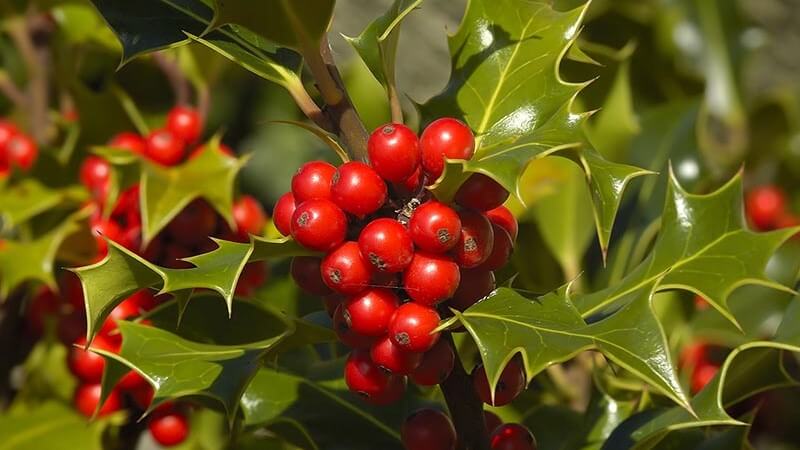Because of the cultural significance of holly, it is actively cultivated in our region. It is not regulated as a state-listed noxious weed and it can legally be cultivated and sold within Oregon. The term “noxious” refers to weeds classified by the Oregon State Weed Board to be “injurious to public health, agriculture, recreation, wildlife, or any public or private property.” This regulatory designation limits the sale and distribution of a plant. Very few culturally and economically significant species receive the noxious weed designation. Although not listed as noxious, holly is widely recognized as an invasive plant in our region.

How Can I Identify English Holly?
Holly is a large, slow growing evergreen, usually found as a shrub or small tree. It has woody stems and its leaves are 2-5 inches long and 1-3 inches wide. The oval, shiny leaves are dark green on the surface, lighter green underneath. Young leaves have three to five sharp spines on each side. Older leaves, and those found higher up in the tree, do not have spines. Flowers of English holly are white, small, and have a sweet scent. This makes them attractive to bees and other pollinators.
Holly berries form on female plants in the fall and can be red, yellow, or orange. The berries contain ilicin, a bitter alkaloid, which make them unpalatable and poisonous to people and pets. Winter frosts soften the berries and make them more tasty to birds and rodents who spread seeds in their droppings. Holly can also spread by suckering and layering.

Why Should I Care About English Holly?
Holly is naturalizing and spreading throughout our area. Coniferous forests are particularly susceptible to invasion. Holly competes with native shrubs and can suppress the natural regeneration of forest trees over time.
Natural resource managers across the Pacific Northwest spend a lot of time and money to treat and control holly in an effort to preserve native forests.
Holly berries contain alkaloids that are generally regarded as toxic to humans and pets.

How Can I Control English Holly?
Because of its invasive nature, Clackamas County property owners are encouraged to remove holly plants. Replace them with non-invasive alternatives whenever possible. The GardenSmart Oregon guide to non-invasive plants lists lists many ornamental and native alternatives. These plants provide similar function and appearance.
Clackamas SWCD encourages growers who are actively cultivating holly to consider phasing out production. This will help to protect your agricultural operations from losses if holly becomes listed as a noxious weed in the future.
Remove holly when the plants are small, when they can be easily hand pulled or dug up. Be sure to remove all parts of the root to limit re-growth. Check the area regularly to remove any new sprouts.
Removal of larger plants may not be feasible and could cause extensive soil disturbance and erosion. In this case, a cut-stem approach that uses a combination of mechanical and chemical control is more effective and may be less damaging to a site. For additional information on this approach, contact the District’s WeedWise program at 503-210-6000.

Our mission: We help people conserve and use natural resources sustainably today and for future generations.

